本文主要分享的是云计算、openstack的使用、私有云平台建设、云服务器云硬盘的构建和使用。从基本概念入手到私有云建设,信息量非常大。对于openstack的安装部署都是从官方文档中一步步的介绍,内容非常详细。
一、云计算 基本概念
云计算(cloud computing)是基于互联网的相关服务的增加、使用和交付模式,通常涉及通过互联网来提供动态易扩展且经常是虚拟化的资源。云是网络、互联网的一种比喻说法。过去在图中往往用云来表示电信网,后来也用来表示互联网和底层基础设施的抽象。因此,云计算甚至可以让你体验每秒10万亿次的运算能力,拥有这么强大的计算能力可以模拟核爆炸、预测气候变化和市场发展趋势。用户通过电脑、笔记本、手机等方式接入数据中心,按自己的需求进行运算。
云计算分类
简单来说,就是把应用程序和数据都放在由大量服务器组成的云中,用户需要什么只要购买相应服务并使用即可。
云计算分为私有云、公有云、混合云。
云计算的服务分类:基础设施即服务、平台即服务、软件即服务。
二、Openstack基本概念
OpenStack是一个开源的云计算管理平台项目,由几个主要的组件组合起来完成
具体工作。OpenStack支持几乎所有类型的云环境,项目目标是提供实施简单、
可大规模扩展、丰富、标准统一的云计算管理平台。OpenStack通过各种互补的
服务提供了基础设施即服务(IaaS)的解决方案,每个服务提供API以进行集成。
常见组件:
基础的系统图
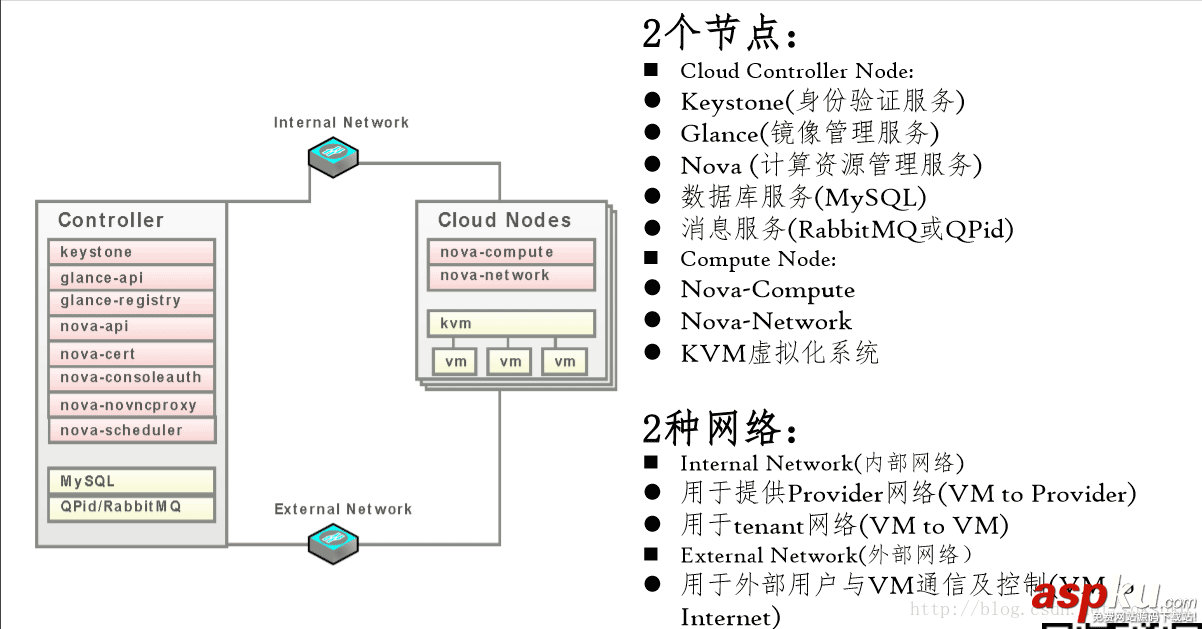
Openstack安装部署
下面来说一说openstack的安装部署。首先说明openstack的整体安装非常复杂,文末提供官方安装文档下载,我就是根据这个英文的官方文档来安装部署的。以下内容是参照官方文档“openstack-install-guide-yum-icehouse.pdf”来的。
首先需要准备3台linux的机器。我这里选用的是centos6.6的64位的系统。配置IP地址,关闭防火墙,修改主机名。
• Controller Node: 1 processor, 2 GB memory, and 5 GB storage
• Compute01: 1 processor, 512 MB memory, and 5 GB storage
• Compute02 Node: 1 processor, 2 GB memory, and 10 GB storage
我这里controller的ip地址是:192.168.44.147
computer01:192.168.44.148
computer02:192.168.44.149
基本环境配置
以下内容是在controller机器上配置的。
1、数据库安装。
因为需要一个数据库,所以这里选用了mysql数据库。
yum install mysql mysql-server MySQL-python
编辑/etc/my.cnf文件,在里面添加如下内容,主要意思就是设置编码为utf-8。
default-storage-engine = innodbinnodb_file_per_tablecollation-server = utf8_general_ciinit-connect = 'SET NAMES utf8'character-set-server = utf8
然后启动服务,开机启动。
# service mysqld start# chkconfig mysqld on# mysql_install_db# mysql_secure_installation
赋权,使其可以远程登录。
GRANT ALL PRIVILEGES ON *.* TO 'root'@'%' IDENTIFIED BY 'a';
2、openstack基本包安装。
# yum install yum-plugin-priorities# yum install http://repos.fedorapeople.org/repos/openstack/openstackicehouse/rdo-release-icehouse-3.noarch.rpm# yum install http://dl.fedoraproject.org/pub/epel/6/x86_64/epel-release-6-8.noarch.rpm# yum install openstack-utils# yum install openstack-selinux
3、安装消息队列
yum install qpid-cpp-server
启动服务
service qpidd startchkconfig qpidd on
权限认证服务(keystone)
安装权限认证服务:
yum install openstack-keystone python-keystoneclient -y
创建用户,写入到配置文件中:
openstack-config --set /etc/keystone/keystone.conf /database connection mysql://keystone:KEYSTONE_DBPASS@controller/keystone
创建keystone数据库表:
$ mysql -u root -pmysql> CREATE DATABASE keystone;mysql> GRANT ALL PRIVILEGES ON keystone.* TO 'keystone'@'localhost' /IDENTIFIED BY 'KEYSTONE_DBPASS';mysql> GRANT ALL PRIVILEGES ON keystone.* TO 'keystone'@'%' /IDENTIFIED BY 'KEYSTONE_DBPASS';mysql> exit
自动生成表:
su -s /bin/sh -c "keystone-manage db_sync" keystone
设置用户环境变量:
ADMIN_TOKEN=$(openssl rand -hex 10)echo $ADMIN_TOKENopenstack-config --set /etc/keystone/keystone.conf DEFAULT /admin_token $ADMIN_TOKEN# keystone-manage pki_setup --keystone-user keystone --keystone-group keystone# chown -R keystone:keystone /etc/keystone/ssl# chmod -R o-rwx /etc/keystone/ssl
启动keystone服务:
service openstack-keystone startchkconfig openstack-keystone on
将admin_token设置到环境变量中去。
export OS_SERVICE_TOKEN=$ADMIN_TOKENexport OS_SERVICE_ENDPOINT=http://controller:35357/v2.0
创建管理员用户,默认的用户名为admin,密码为ADMIN_PASS,你可以自定义修改:
[root@controller keystone]# keystone user-create --name=admin --pass=ADMIN_PASS --email=ADMIN_EMAIL+----------+----------------------------------+| Property | Value |+----------+----------------------------------+| email | ADMIN_EMAIL|| enabled | True ||id| 332f5ecb18c64bf687b154facd629fb6 || name | admin || username | admin |+----------+----------------------------------+[root@controller keystone]# keystone role-create --name=admin+----------+----------------------------------+| Property | Value |+----------+----------------------------------+|id| ab5da2c50d7443efb0514e84c2b4adb7 || name | admin |+----------+----------------------------------+[root@controller keystone]# keystone tenant-create --name=admin --description="Admin Tenant"+-------------+----------------------------------+| Property | Value |+-------------+----------------------------------+| description | Admin Tenant || enabled | True || id | b89723a38b154eeea6416a83b293b0ad || name| admin |+-------------+----------------------------------+[root@controller keystone]# keystone user-role-add --user=admin --tenant=admin --role=admin[root@controller keystone]# keystone user-role-add --user=admin --role=_member_ --tenant=admin[root@controller keystone]#
创建一个权限认证服务,因为我这里的主机名是controller,所以下面有 http://controller:35357/v2.0 这些信息,可以自定义修改:
[root@controller keystone]# keystone service-create --name=keystone --type=identity /> --description="OpenStack Identity"+-------------+----------------------------------+| Property | Value |+-------------+----------------------------------+| description |OpenStack Identity|| enabled | True || id | 4bfd5f39b86c45edb92d5c0488987dd8 || name| keystone || type| identity |+-------------+----------------------------------+[root@controller keystone]# keystone endpoint-create /> --service-id=$(keystone service-list | awk '/ identity / {print $2}') /> --publicurl=http://controller:5000/v2.0 /> --internalurl=http://controller:5000/v2.0 /> --adminurl=http://controller:35357/v2.0+-------------+----------------------------------+| Property | Value |+-------------+----------------------------------+| adminurl | http://controller:35357/v2.0 || id | 0350b72901a141498fe48304b13a1b98 || internalurl | http://controller:5000/v2.0|| publicurl | http://controller:5000/v2.0||region |regionOne || service_id | 4bfd5f39b86c45edb92d5c0488987dd8 |+-------------+----------------------------------+[root@controller keystone]# keystone user-create --name=demo --pass=DEMO_PASS --email=DEMO_EMAIL+----------+----------------------------------+| Property | Value |+----------+----------------------------------+| email |DEMO_EMAIL|| enabled | True ||id| b44a9a1462d74f4e928b3b339289a2ae || name | demo || username | demo |+----------+----------------------------------+[root@controller keystone]# keystone tenant-create --name=demo --description="Demo Tenant"+-------------+----------------------------------+| Property | Value |+-------------+----------------------------------+| description | Demo Tenant|| enabled | True || id | 7bd79509ee184a2098ca0644679b60a8 || name| demo |+-------------+----------------------------------+[root@controller keystone]# keystone user-role-add --user=demo --role=_member_ --tenant=demo[root@controller keystone]#为了方便我们取到token,我们可以vi admin-openrc.sh,然后添加如下内容:
export OS_USERNAME=adminexport OS_PASSWORD=ADMIN_PASSexport OS_TENANT_NAME=adminexport OS_AUTH_URL=http://controller:35357/v2.0
在每次关机重启之后都要重新执行下面的命令,让环境变量起作用。否则会报”Expecting an auth URL via either –os-auth-url or env[OS_AUTH_URL]”的错误:
source admin-openrc.sh
我们可以使用下面的命令查看keystone目前的用户有哪些:
keystone user-list
测试效果:
打开restclient-ui-3.5-jar-with-dependencies.jar来测试效果:
url地址是: http://192.168.44.147:5000/v2.0/
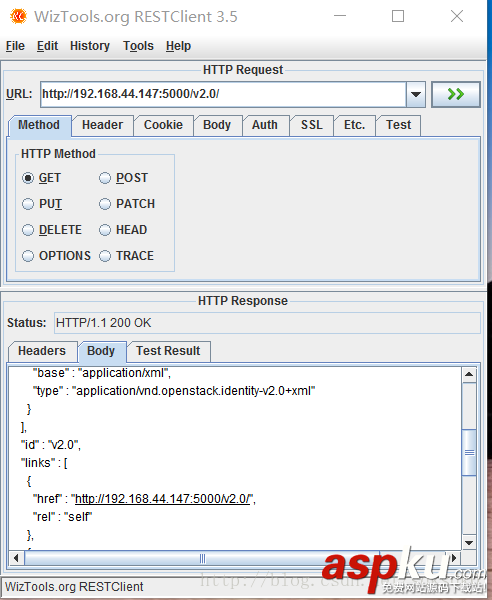
访问成功。
配置镜像服务(glance)
在controller服务器中安装服务:
yum install openstack-glance python-glanceclientopenstack-config --set /etc/glance/glance-api.conf database /connection mysql://glance:GLANCE_DBPASS@controller/glanceopenstack-config --set /etc/glance/glance-registry.conf database /connection mysql://glance:GLANCE_DBPASS@controller/glance
在mysql数据库中创建glance数据库:
$ mysql -u root -pmysql> CREATE DATABASE glance;mysql> GRANT ALL PRIVILEGES ON glance.* TO 'glance'@'localhost' /IDENTIFIED BY 'GLANCE_DBPASS';mysql> GRANT ALL PRIVILEGES ON glance.* TO 'glance'@'%' /IDENTIFIED BY 'GLANCE_DBPASS';flush privileges;
自动生成表:
su -s /bin/sh -c "glance-manage db_sync" glance
在keystone上创建用户:
keystone user-create --name=glance --pass=GLANCE_PASS --email=glance@example.com$ keystone user-role-add --user=glance --tenant=service --role=admin
配置授权服务:
openstack-config --set /etc/glance/glance-api.conf keystone_authtoken /auth_uri http://controller:5000openstack-config --set /etc/glance/glance-api.conf keystone_authtoken /auth_host controlleropenstack-config --set /etc/glance/glance-api.conf keystone_authtoken /auth_port 35357openstack-config --set /etc/glance/glance-api.conf keystone_authtoken /auth_protocol httpopenstack-config --set /etc/glance/glance-api.conf keystone_authtoken /admin_tenant_name serviceopenstack-config --set /etc/glance/glance-api.conf keystone_authtoken /admin_user glanceopenstack-config --set /etc/glance/glance-api.conf keystone_authtoken /admin_password GLANCE_PASSopenstack-config --set /etc/glance/glance-api.conf paste_deploy /flavor keystoneopenstack-config --set /etc/glance/glance-registry.conf keystone_authtoken /auth_uri http://controller:5000openstack-config --set /etc/glance/glance-registry.conf keystone_authtoken /auth_host controlleropenstack-config --set /etc/glance/glance-registry.conf keystone_authtoken /auth_port 35357openstack-config --set /etc/glance/glance-registry.conf keystone_authtoken /auth_protocol httpopenstack-config --set /etc/glance/glance-registry.conf keystone_authtoken /admin_tenant_name serviceopenstack-config --set /etc/glance/glance-registry.conf keystone_authtoken /admin_user glanceopenstack-config --set /etc/glance/glance-registry.conf keystone_authtoken /admin_password GLANCE_PASSopenstack-config --set /etc/glance/glance-registry.conf paste_deploy /flavor keystone
启动服务:
service openstack-glance-api start# service openstack-glance-registry start# chkconfig openstack-glance-api on# chkconfig openstack-glance-registry on
创建服务:
$ keystone service-create --name=glance --type=image /--description="OpenStack Image Service"$ keystone endpoint-create /--service-id=$(keystone service-list | awk '/ image / {print $2}') /--publicurl=http://controller:9292 /--internalurl=http://controller:9292 /--adminurl=http://controller:9292[root@controller ~]# keystone service-create --name=glance --type=image /> --description="OpenStack Image Service"/usr/lib64/python2.6/site-packages/Crypto/Util/number.py:57: PowmInsecureWarning: Not using mpz_powm_sec. You should rebuild using libgmp >= 5 to avoid timing attack vulnerability. _warn("Not using mpz_powm_sec. You should rebuild using libgmp >= 5 to avoid timing attack vulnerability.", PowmInsecureWarning)+-------------+----------------------------------+| Property | Value |+-------------+----------------------------------+| description | OpenStack Image Service || enabled | True || id | a45f77cfc12c42d19a45a6ea12cdfc51 || name| glance || type| image |+-------------+----------------------------------+[root@controller ~]# keystone endpoint-create /> --service-id=$(keystone service-list | awk '/ image / {print $2}') /> --publicurl=http://controller:9292 /> --internalurl=http://controller:9292 /> --adminurl=http://controller:9292+-------------+----------------------------------+| Property | Value |+-------------+----------------------------------+| adminurl | http://controller:9292 || id | 75deb2d2f85e4b7b88fe18bf5fca1a87 || internalurl | http://controller:9292 || publicurl | http://controller:9292 ||region |regionOne || service_id | a45f77cfc12c42d19a45a6ea12cdfc51 |+-------------+----------------------------------+创建镜像,先将下载好的cirros-0.3.2-x86_64-disk.img放置在/root目录下,然后执行下面的命令:
查看镜像列表:
glance image-list

在前面我们已经对kvm虚拟化有所了解,所以我们现在知道qcow2就是一个镜像文件。
服务器管理(Nova)
对于虚拟机管理我们需要从controller和computer01进行配置。
先来看controller的配置:
yum install openstack-nova-api openstack-nova-cert openstack-nova-conductor /openstack-nova-console openstack-nova-novncproxy openstack-nova-scheduler /python-novaclient$ mysql -u root -pmysql> CREATE DATABASE nova;mysql> GRANT ALL PRIVILEGES ON nova.* TO 'nova'@'localhost' /IDENTIFIED BY 'NOVA_DBPASS';mysql> GRANT ALL PRIVILEGES ON nova.* TO 'nova'@'%' /IDENTIFIED BY 'NOVA_DBPASS';openstack-config --set /etc/nova/nova.conf database connection mysql://nova:NOVA_DBPASS@controller/novaopenstack-config --set /etc/nova/nova.conf DEFAULT rpc_backend qpidopenstack-config --set /etc/nova/nova.conf DEFAULT qpid_hostname controlleropenstack-config --set /etc/nova/nova.conf DEFAULT my_ip 192.168.44.147openstack-config --set /etc/nova/nova.conf DEFAULT vncserver_listen 192.168.216.210openstack-config --set /etc/nova/nova.conf DEFAULT vncserver_proxyclient_address 192.168.44.147openstack-config --set /etc/nova/nova.conf DEFAULT auth_strategy keystoneopenstack-config --set /etc/nova/nova.conf keystone_authtoken auth_uri http://controller:5000openstack-config --set /etc/nova/nova.conf keystone_authtoken auth_host controlleropenstack-config --set /etc/nova/nova.conf keystone_authtoken auth_protocol httpopenstack-config --set /etc/nova/nova.conf keystone_authtoken auth_port 35357openstack-config --set /etc/nova/nova.conf keystone_authtoken admin_user novaopenstack-config --set /etc/nova/nova.conf keystone_authtoken admin_tenant_name serviceopenstack-config --set /etc/nova/nova.conf keystone_authtoken admin_password NOVA_PASS$ keystone user-create --name=nova --pass=NOVA_PASS --email=nova@example.com$ keystone user-role-add --user=nova --tenant=service --role=admin$ keystone service-create --name=nova --type=compute /--description="OpenStack Compute"$ keystone endpoint-create /--service-id=$(keystone service-list | awk '/ compute / {print $2}') /--publicurl=http://controller:8774/v2/%/(tenant_id/)s /--internalurl=http://controller:8774/v2/%/(tenant_id/)s /--adminurl=http://controller:8774/v2/%/(tenant_id/)s然后是computer01的配置:
yum install openstack-nova-compute openstack-config --set /etc/nova/nova.conf database connection mysql://nova:NOVA_DBPASS@controller/nova openstack-config --set /etc/nova/nova.conf DEFAULT auth_strategy keystone openstack-config --set /etc/nova/nova.conf keystone_authtoken auth_uri http://controller:5000 openstack-config --set /etc/nova/nova.conf keystone_authtoken auth_host controller openstack-config --set /etc/nova/nova.conf keystone_authtoken auth_protocol http openstack-config --set /etc/nova/nova.conf keystone_authtoken auth_port 35357 openstack-config --set /etc/nova/nova.conf keystone_authtoken admin_user nova openstack-config --set /etc/nova/nova.conf keystone_authtoken admin_tenant_name service openstack-config --set /etc/nova/nova.conf keystone_authtoken admin_password NOVA_PASS openstack-config --set /etc/nova/nova.conf DEFAULT rpc_backend qpid openstack-config --set /etc/nova/nova.conf DEFAULT qpid_hostname controller openstack-config --set /etc/nova/nova.conf DEFAULT my_ip 192.168.44.148 openstack-config --set /etc/nova/nova.conf DEFAULT vnc_enabled True openstack-config --set /etc/nova/nova.conf DEFAULT vncserver_listen 0.0.0.0 openstack-config --set /etc/nova/nova.conf DEFAULT vncserver_proxyclient_address 192.168.44.148 openstack-config --set /etc/nova/nova.conf DEFAULT novncproxy_base_url http://controller:6080/vnc_auto.htmlopenstack-config --set /etc/nova/nova.conf DEFAULT glance_host controlleropenstack-config --set /etc/nova/nova.conf libvirt virt_type kvm
启动服务:
service libvirtd start service messagebus start service openstack-nova-compute start chkconfig libvirtd on chkconfig messagebus on chkconfig openstack-nova-compute on
网络服务配置
在controller端:
openstack-config --set /etc/nova/nova.conf DEFAULT /network_api_class nova.network.api.APIopenstack-config --set /etc/nova/nova.conf DEFAULT /security_group_api nova
在computer01端:
yum install openstack-nova-network openstack-nova-api# openstack-config --set /etc/nova/nova.conf DEFAULT /network_api_class nova.network.api.API# openstack-config --set /etc/nova/nova.conf DEFAULT /security_group_api nova# openstack-config --set /etc/nova/nova.conf DEFAULT /network_manager nova.network.manager.FlatDHCPManager# openstack-config --set /etc/nova/nova.conf DEFAULT /firewall_driver nova.virt.libvirt.firewall.IptablesFirewallDriver# openstack-config --set /etc/nova/nova.conf DEFAULT /network_size 254# openstack-config --set /etc/nova/nova.conf DEFAULT /allow_same_net_traffic False# openstack-config --set /etc/nova/nova.conf DEFAULT /multi_host True# openstack-config --set /etc/nova/nova.conf DEFAULT /send_arp_for_ha True# openstack-config --set /etc/nova/nova.conf DEFAULT /share_dhcp_address True# openstack-config --set /etc/nova/nova.conf DEFAULT /force_dhcp_release True# openstack-config --set /etc/nova/nova.conf DEFAULT /flat_network_bridge br100# openstack-config --set /etc/nova/nova.conf DEFAULT /flat_interface eth1# openstack-config --set /etc/nova/nova.conf DEFAULT /public_interface eth0
nova network-create demo-net –bridge br100 –multi-host T /
–fixed-range-v4 88.8.8.16/28
然后使用nova net-list来查看:

创建虚拟机
1、配置ssh密码登录:
ssh-keygen
2、增加公钥到openstack环境中:
nova keypair-add --pub-key ~/.ssh/id_rsa.pub demo-key
3、验证是否配置成功:
nova keypair-listnova flavor-list
4、创建实例:
说明:
DEMO_NET_ID:指的是nova net-list的ID。
demo-instance1指的是虚拟机的名字。
例如我的成功执行如下:
nova boot --flavor m1.tiny --image cirros-0.3.2-x86_64 --nic net-id=55fc305f-570f-4d4f-89d0-ce303e589f20 /--security-group default --key-name demo-key tfjt
5、使用nova list进行查看。

从这里我们看到我这上面有一个ip地址192.168.44.17.这个地址就是浮动IP。
6、配置浮动IP
浮动ip
nova-manage floating create --ip_range=192.168.44.16/28
查看可用地址
nova-manage floating list
nova floating-ip-create
给创建的虚拟机绑定浮动ip,这个7bc0086…就是我之前创建的虚拟机的ID。后面接上IP地址即可。
nova add-floating-ip 7bc00086-1870-4367-9f05-666d5067ccff 192.168.44.17
监听
cpdump -n -i eth0 icmp
在controller上:
nova secgroup-add-rule default icmp -1 -1 0.0.0.0/0
nova secgroup-add-rule default tcp 22 22 0.0.0.0/0
7、使用下面的命令可以输出一个url地址:
nova get-vnc-console tfjt novnc

8、我们可以在浏览器中进行访问。
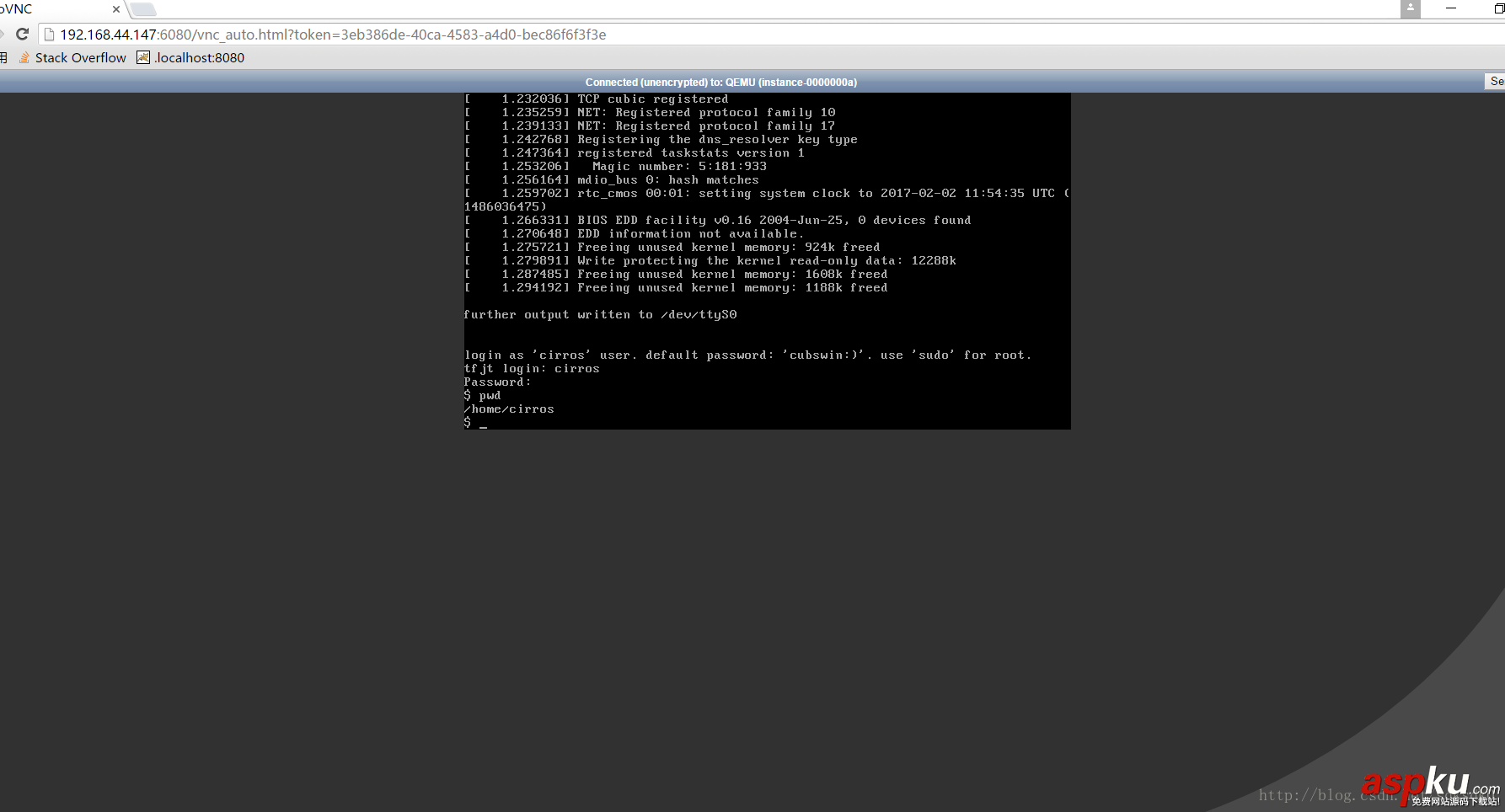
到这里为止,我们的云服务器就算完成了。可以在浏览器上访问我们的云服务器,怎么样是不是很激动。
界面服务(dashboard)
上面我们可以看到很多操作是在终端进行的,那么肯定是有界面版的,所以我们在computer02中进行配置。
1、安装服务
yum install memcached python-memcached mod_wsgi openstack-dashboard
2、文件配置。
在controller中
配置/etc/openstack-dashboard/local_settings。修改为如下内容。
ALLOWED_HOSTS = ['*']CACHES = {'default': {'BACKEND' : 'django.core.cache.backends.memcached.MemcachedCache','LOCATION' : '127.0.0.1:11211'}}OPENSTACK_HOST = "controller"3、连接
setsebool -P httpd_can_network_connect onservice httpd start# service memcached start# chkconfig httpd on# chkconfig memcached on
4、浏览器中访问。
http://192.168.44.147/dashboard/project/
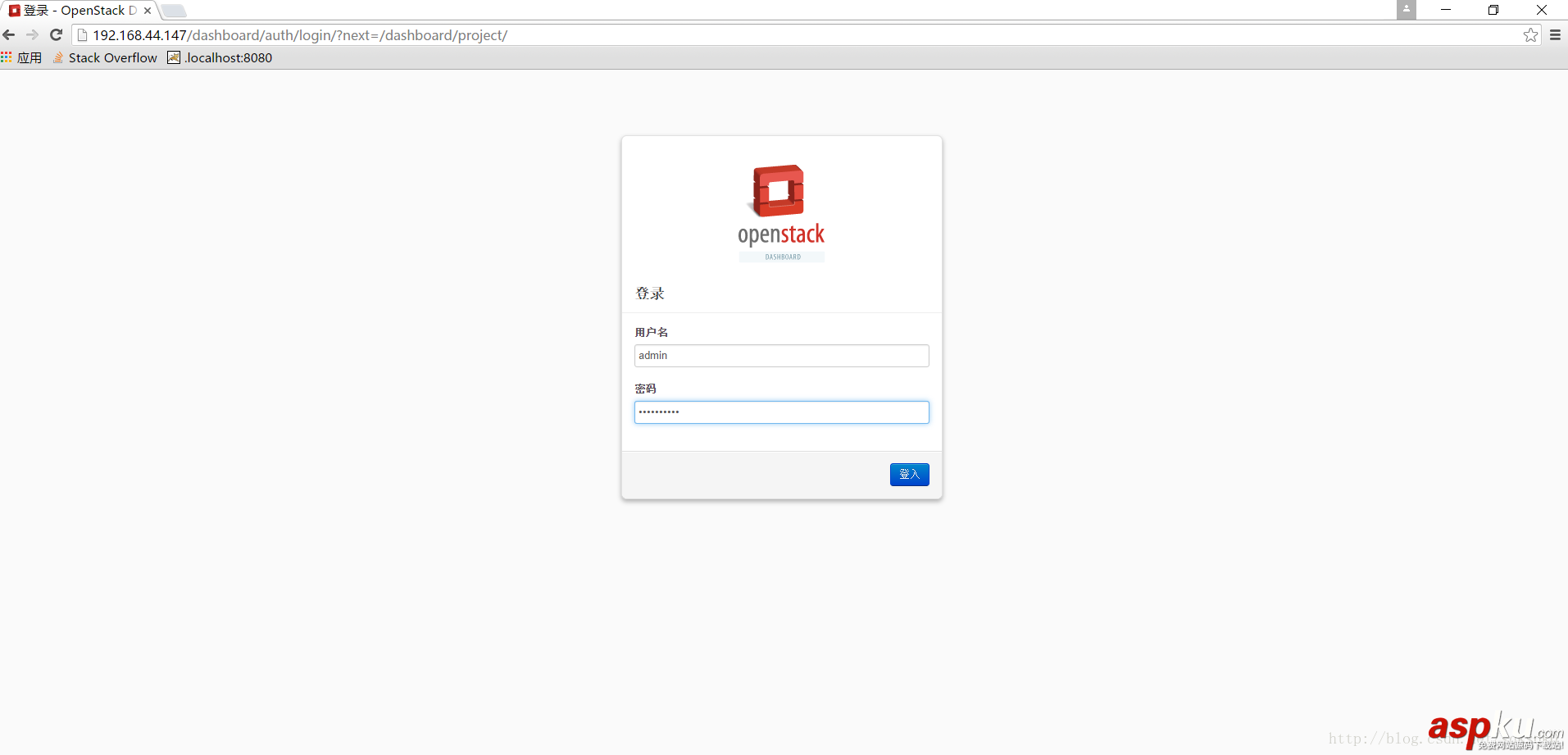
用户名就是我们之前配置的admin,密码是ADMIN_PASS
在这个界面版里面的各种操作我这里就不细说了,可以自己去体验。
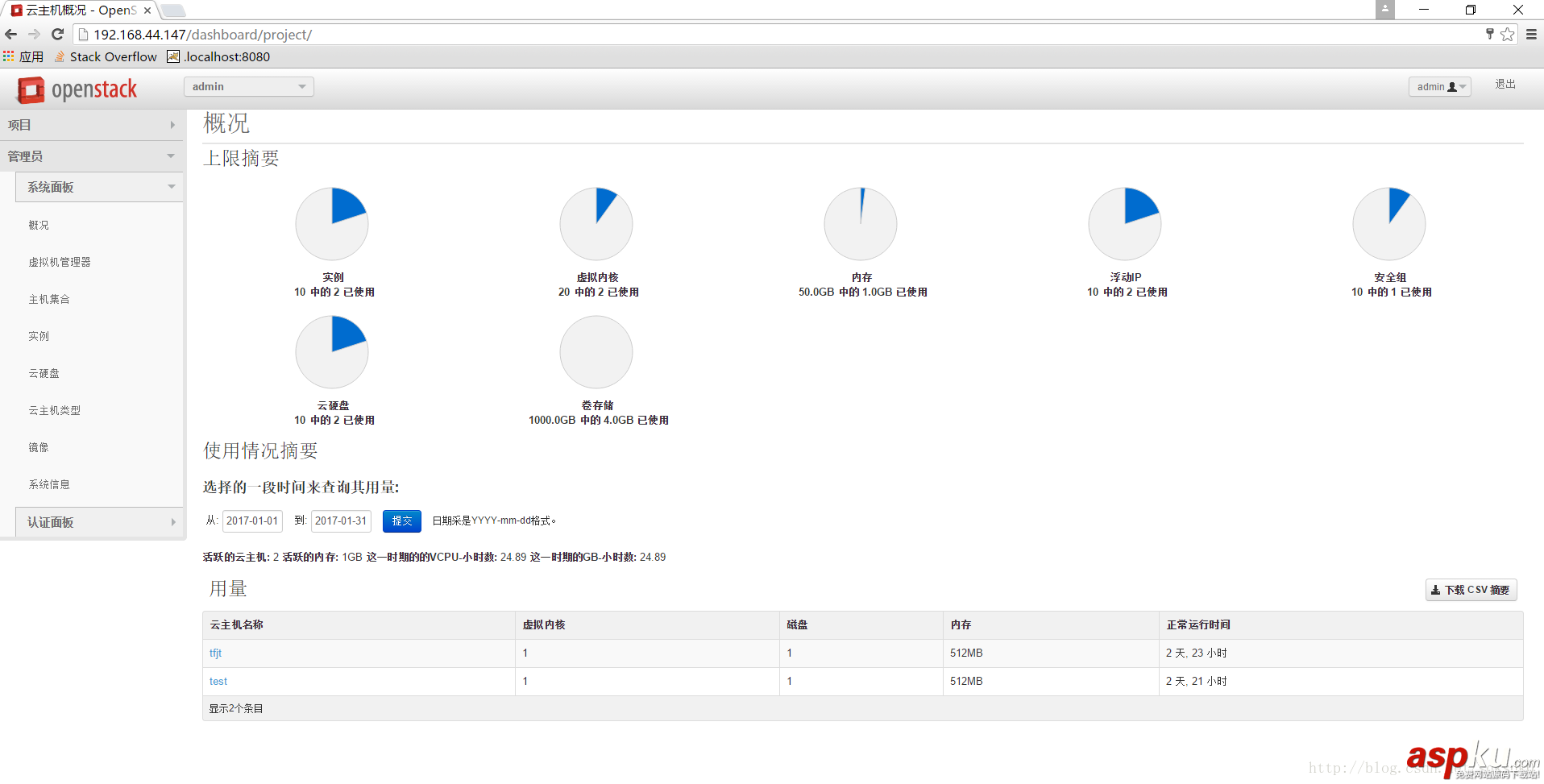
在这里可以看到我们的云服务器实例。

云硬盘服务(cinder)
了解过阿里云或者腾讯云的就知道,里面都有一个云硬盘服务,可以给我们的机器增加磁盘。
在controller端:
yum stall openstack-cindeopenstack-config --set /etc/cinder/cinder.conf /database connection mysql://cinder:CINDER_DBPASS@controller/cindermysql> CREATE DATABASE cinder;mysql> GRANT ALL PRIVILEGES ON cinder.* TO 'cinder'@'localhost' /IDENTIFIED BY 'CINDER_DBPASS';mysql> GRANT ALL PRIVILEGES ON cinder.* TO 'cinder'@'%' /IDENTIFIED BY 'CINDER_DBPASS';
创建数据库表:
# su -s /bin/sh -c "cinder-manage db sync" cinder
创建用户并赋予角色:
$ keystone user-create --name=cinder --pass=CINDER_PASS--email=cinder@example.com$ keystone user-role-add --user=cinder --tenant=service --role=admin
权限控制配置:
# openstack-config --set /etc/cinder/cinder.conf DEFAULT /auth_strategy keystone# openstack-config --set /etc/cinder/cinder.conf keystone_authtoken /auth_uri http://controller:5000# openstack-config --set /etc/cinder/cinder.conf keystone_authtoken /auth_host controller# openstack-config --set /etc/cinder/cinder.conf keystone_authtoken /auth_protocol http# openstack-config --set /etc/cinder/cinder.conf keystone_authtoken /auth_port 35357# openstack-config --set /etc/cinder/cinder.conf keystone_authtoken /admin_user cinder# openstack-config --set /etc/cinder/cinder.conf keystone_authtoken /admin_tenant_name service# openstack-config --set /etc/cinder/cinder.conf keystone_authtoken /admin_password CINDER_PASS
消息队列配置:
# openstack-config --set /etc/cinder/cinder.conf /DEFAULT rpc_backend qpid# openstack-config --set /etc/cinder/cinder.conf /DEFAULT qpid_hostname controller$ keystone service-create --name=cinder --type=volume --description="OpenStack Block Storage"$ keystone endpoint-create /--service-id=$(keystone service-list | awk '/ volume / {print $2}') /--publicurl=http://controller:8776/v1/%/(tenant_id/)s /--internalurl=http://controller:8776/v1/%/(tenant_id/)s /--adminurl=http://controller:8776/v1/%/(tenant_id/)s$ keystone service-create --name=cinderv2 --type=volumev2 --description="OpenStack Block Storage v2"$ keystone endpoint-create /--service-id=$(keystone service-list | awk '/ volumev2 / {print $2}') /--publicurl=http://controller:8776/v2/%/(tenant_id/)s /--internalurl=http://controller:8776/v2/%/(tenant_id/)s /--adminurl=http://controller:8776/v2/%/(tenant_id/)sservice openstack-cinder-api start# service openstack-cinder-scheduler start# chkconfig openstack-cinder-api on# chkconfig openstack-cinder-scheduler oncinder service-listopenstack-config --set /etc/cinder/cinder.conf /DEFAULT qpid_hostname controllercinder --debug listkeystone user-create --name=cinder --pass=CINDER_PASS --email=cinder@example.comopenstack-config --set /etc/cinder/cinder.conf /DEFAULT my_ip 192.168.44.147在node端(computer02)
pvcreate /dev/sdb# vgcreate cinder-volumes /dev/sdb yum install openstack-cinder scsi-target-utils# openstack-config --set /etc/cinder/cinder.conf DEFAULT /auth_strategy keystone# openstack-config --set /etc/cinder/cinder.conf keystone_authtoken /auth_uri http://controller:5000# openstack-config --set /etc/cinder/cinder.conf keystone_authtoken /auth_host controller# openstack-config --set /etc/cinder/cinder.conf keystone_authtoken /auth_protocol http# openstack-config --set /etc/cinder/cinder.conf keystone_authtoken /auth_port 35357# openstack-config --set /etc/cinder/cinder.conf keystone_authtoken /admin_user cinder# openstack-config --set /etc/cinder/cinder.conf keystone_authtoken /admin_tenant_name service# openstack-config --set /etc/cinder/cinder.conf keystone_authtoken /admin_password CINDER_PASS# openstack-config --set /etc/cinder/cinder.conf /DEFAULT rpc_backend qpid# openstack-config --set /etc/cinder/cinder.conf /DEFAULT qpid_hostname controller# openstack-config --set /etc/cinder/cinder.conf /database connection mysql://cinder:CINDER_DBPASS@controller/cinde# openstack-config --set /etc/cinder/cinder.conf /DEFAULT my_ip MANAGEMENT_INTERFACE_IP_ADDRESS# openstack-config --set /etc/cinder/cinder.conf /DEFAULT glance_host controller# openstack-config --set /etc/cinder/cinder.conf /DEFAULT iscsi_helper tgtadm
配置文件中:
vi /etc/tgt/targets.conf
include /etc/cinder/volumes/*
启动服务:
# service openstack-cinder-volume start# service tgtd start# chkconfig openstack-cinder-volume on# chkconfig tgtd on
创建磁盘:
cinder create --display-name myVolume 1
查看磁盘列表:
cinder list
然后再界面端查看云硬盘的配置并进行挂载:

在云服务器上挂载磁盘:
$ mkfs.ext3 /dev/vdb1$ mkdir /mnt/test$ mount /dev/vdb1 /mnt/test$ mount$ fdisk /dev/vdbDevice contains neither a valid DOS partition table, nor Sun, SGI or OSF disklabelBuilding a new DOS disklabel with disk identifier 0x64817ea3.Changes will remain in memory only, until you decide to write them.After that, of course, the previous content won't be recoverable.Warning: invalid flag 0x0000 of partition table 4 will be corrected by w(rite)Command (m for help): nPartition type: p primary (0 primary, 0 extended, 4 free) e extendedSelect (default p): pPartition number (1-4, default 1): 1First sector (2048-2097151, default 2048): +1GValue out of range.First sector (2048-2097151, default 2048): +512MLast sector, +sectors or +size{K,M,G} (1048576-2097151, default 2097151): Using default value 2097151Command (m for help): pDisk /dev/vdb: 1073 MB, 1073741824 bytes16 heads, 63 sectors/track, 2080 cylinders, total 2097152 sectorsUnits = sectors of 1 * 512 = 512 bytesSector size (logical/physical): 512 bytes / 512 bytesI/O size (minimum/optimal): 512 bytes / 512 bytesDisk identifier: 0x64817ea3 Device Boot Start End Blocks Id System/dev/vdb1 1048576 2097151 524288 83 LinuxCommand (m for help): wThe partition table has been altered!Calling ioctl() to re-read partition table.Syncing disks.$ df -h 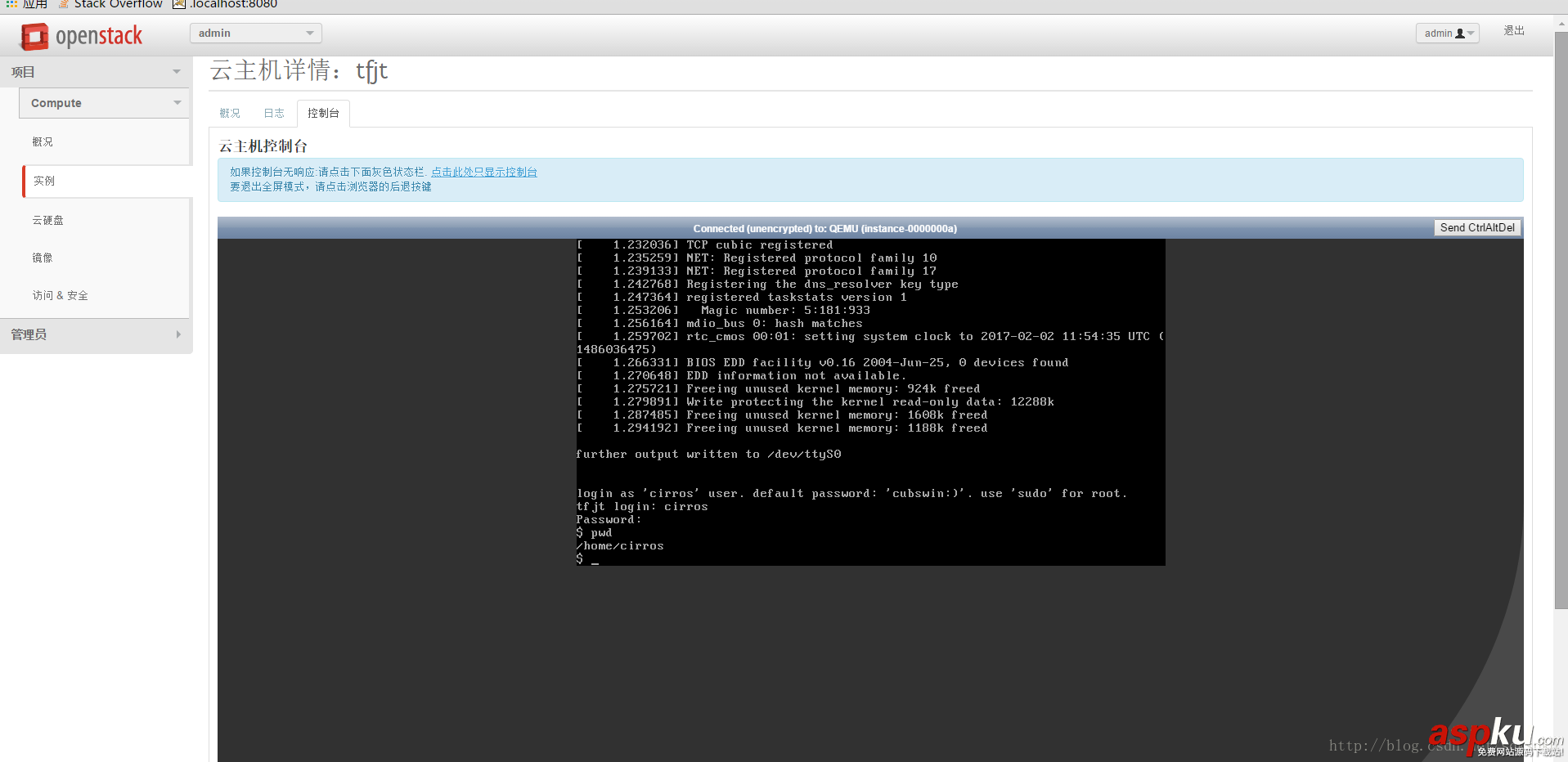
总结:整个操作流程非常复杂,我也是花了几天才慢慢搭建好的,这其实也就是个基础,给的其实是一个思路,后面需要怎样的扩展可以根据自己的业务需要进行不同的设置。对于不明白的地方可以查阅官方文档。
新闻热点
疑难解答
图片精选